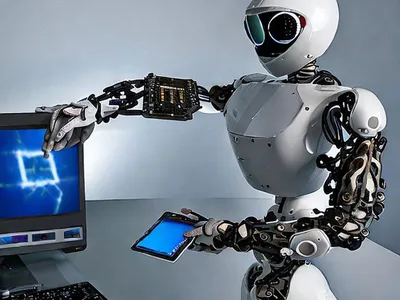As artificial intelligence continues to evolve, tools like ChatGPT, Bard, and Claude are becoming increasingly proficient at generating human-like content. While these advancements present incredible opportunities, they also raise concerns about authenticity, transparency, and academic or journalistic integrity. To address these concerns, AI content detection tools—commonly referred to as “Detector de IA” in Spanish and “Détecteur IA” in French—are gaining prominence.
What Is a Detector de IA / Détecteur IA?
A Detector de IA (Spanish) or Détecteur IA (French) is a tool designed to identify whether a piece of content—text, image, or video—was created by artificial intelligence. These detectors serve a wide array of industries, including education, publishing, journalism, and marketing.
With growing reliance on generative AI, it’s becoming increasingly difficult to distinguish between content created by humans and that generated by machines. This is where AI detectors come in, helping users verify authenticity and avoid potential misuse.
How Do AI Detectors Work?
AI detectors employ sophisticated algorithms and deep learning models that analyze various factors within a given text or image. Here’s a closer look at how these tools function:
1. Linguistic Pattern Recognition
Generative AI tools often leave behind distinct linguistic patterns. For instance, they may use:
-
Repetitive phrases
-
Overly structured sentences
-
Predictable grammar usage
An AI detector scans for these patterns and assigns a probability score indicating whether the content was AI-generated.
2. Perplexity and Burstiness Metrics
Many detectors use metrics like perplexity (how predictable a sentence is) and burstiness (variation in sentence length and structure). Human writing generally has higher burstiness and lower predictability, whereas AI writing tends to be more uniform.
3. Machine Learning Classifiers
Advanced detectors use machine learning classifiers trained on datasets of human-written and AI-generated content. These models “learn” the subtle differences between the two and make predictions accordingly.
4. Metadata Analysis
Some detectors also analyze metadata, such as document creation timestamps or file properties, which may provide hints about content origin.
Why Are AI Detectors Important?
The need for Detector de IA or Détecteur IA tools is more urgent than ever. Here are several key reasons why these detectors are essential:
1. Academic Integrity
Students increasingly use AI tools to complete assignments and essays. Educational institutions need reliable detectors to ensure that submitted work is original and not entirely AI-generated.
2. Combatting Misinformation
Fake news and misleading articles can now be rapidly generated using AI. Detection tools help journalists and fact-checkers verify the authenticity of such content.
3. Brand Reputation
Companies rely on original content for SEO and brand trust. AI-generated content that violates originality standards can hurt a brand’s search engine rankings and reputation.
4. Content Authenticity in Publishing
In publishing and media, human creativity and authenticity are valued. AI detectors ensure that published articles and stories are the result of human effort, preserving journalistic standards.
Popular AI Content Detectors in 2025
As of 2025, several Detector de IA and Détecteur IA tools are gaining popularity across different languages and regions:
1. GPTZero
Designed specifically for educators, GPTZero can detect AI-generated student work and provide a sentence-level breakdown.
2. Originality.AI
Widely used by content marketers and SEO professionals, this tool offers plagiarism detection alongside AI content detection.
3. Copyleaks AI Content Detector
Used by universities and publishers, Copyleaks uses deep learning to identify whether content is generated by tools like ChatGPT or Google Bard.
4. ZeroGPT
This free tool is useful for quick checks and is accessible to non-technical users who want fast detection results.
Limitations of AI Detectors
Despite their usefulness, AI detectors are not perfect. Understanding their limitations is important for using them effectively.
1. False Positives
Sometimes, human-written content may be flagged as AI-generated due to its structure or language patterns.
2. False Negatives
Conversely, sophisticated AI-generated content can occasionally pass undetected if it’s heavily edited or cleverly constructed.
3. Language Support
Most detectors are optimized for English. While “Detector de IA” and “Détecteur IA” tools are emerging for Spanish and French, their accuracy may vary.
4. Evolving AI Models
As generative AI becomes more advanced, detection tools must also adapt. Tools trained on older models may not detect content created by newer AI systems.
Applications Across Industries
AI detectors are being used in multiple sectors beyond education and publishing. Let’s explore how different industries benefit from these tools:
1. Human Resources
Employers use AI detectors to assess job applications and cover letters to ensure candidates are submitting genuine work.
2. Legal Industry
In legal research and documentation, verifying the source and originality of text is crucial. AI detectors help ensure the integrity of legal documents.
3. E-commerce and Reviews
AI-generated fake reviews can mislead consumers. E-commerce platforms use detection tools to flag and remove inauthentic reviews.
4. Advertising and Copywriting
Brands ensure that marketing content is uniquely crafted rather than generated through templates or AI tools, maintaining brand voice and originality.
Best Practices for Using AI Detectors
To maximize the effectiveness of AI detection tools, consider the following best practices:
-
Use multiple tools for cross-verification.
-
Manually review flagged content to understand why it was marked.
-
Update detection tools regularly to keep pace with evolving AI models.
-
Educate users—especially students and employees—about acceptable AI usage and the importance of original content.
The Future of AI Detection
The future of Detector de IA and Détecteur IA tools looks promising, with advancements likely in the following areas:
-
Multilingual detection models with higher accuracy for non-English content
-
Real-time detection plugins for browsers and word processors
-
Integration with plagiarism checkers for comprehensive content validation
-
Improved accuracy through continual machine learning training
As AI continues to shape our digital world, the tools to monitor and manage its output will be just as critical as the AI systems themselves.
Conclusion
The emergence of Detector de IA and Détecteur IA tools marks a pivotal shift in how we manage, trust, and evaluate content in the digital age. Whether in academia, media, or business, these tools ensure that authenticity remains a cornerstone of communication. As AI continues to blur the lines between human and machine, content detection technologies will play an increasingly important role in preserving originality, trust, and transparency.
Check out new and latest article to see by clicking here.








